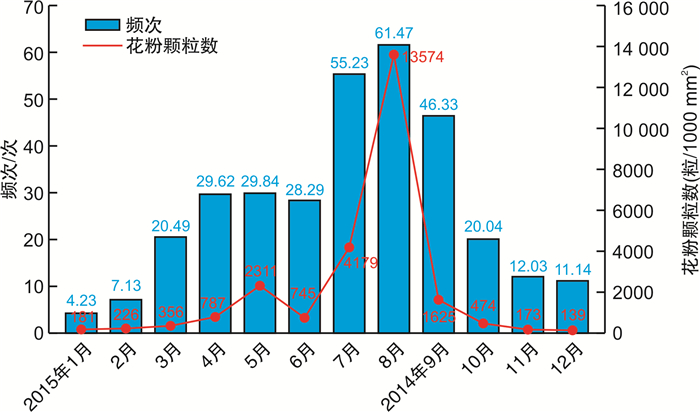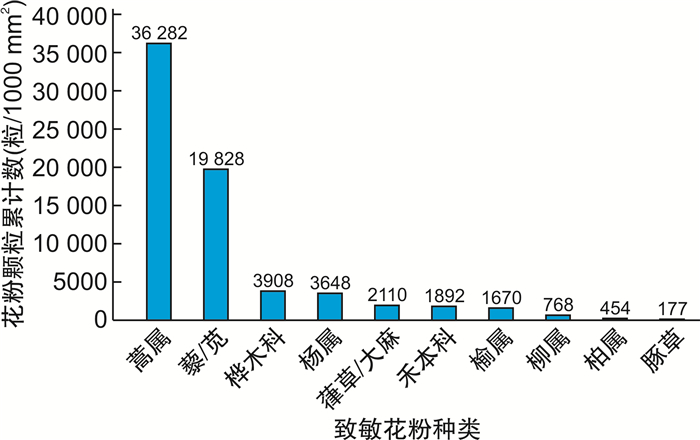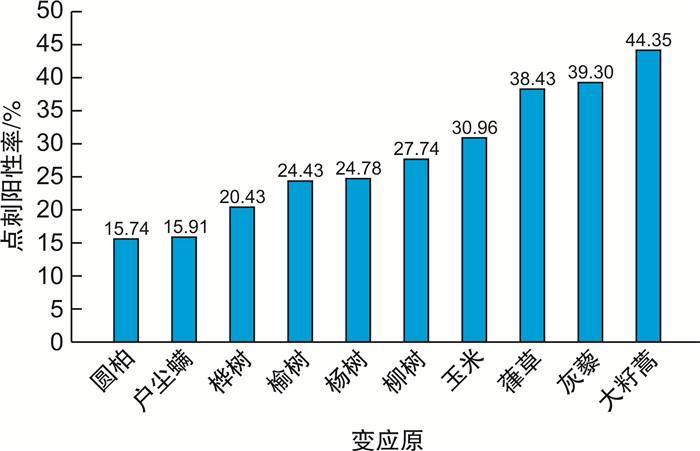Epidemiological survey of allergic rhinitis in steppe area of Xilingol League, Inner Mongolian of China
-
摘要: 目的 调查内蒙古锡林郭勒盟草原地区变应性鼻炎(AR)的流行病学情况(患病率、临床特征、主要变应原等),为防治AR提供科学依据。方法 严格按照流行病学调查要求采用多阶段、分层、随机、整群抽样的方法调查内蒙古锡林郭勒草原3个地区(锡林浩特、二连浩特、多伦)人群,采用面对面问卷调查形式调查人群的一般情况、AR的主要临床症状及相关症状、合并疾病情况,同时进行10种草原变应原皮肤点刺试验(SPT),并采用用重力沉降法监测该地区每天的花粉种类及数量。应用SAS软件9.4进行数据处理。结果 整群抽样的2878人完成了问卷调查和变应原检测,皮肤点刺试验阳性率为41.10%(1179/2787);AR自报患病率为39.96%(1150/2878),确诊患病率为22.72%(654/2878)。AR鼻部症状以喷嚏、鼻痒最明显,其中喷嚏占91.13%(1048/1150),鼻痒占85.65%(985/1150);眼部症状中眼痒、流泪症状最明显,眼痒症状占55.13%(634/1150)、流泪症状占42.96%(494/1150)。在AR其他相关症状中,乏力和嗜睡表现突出。AR合并结膜炎60.52%(696/1150),AR合并哮喘13.57%(156/1150)。AR的主要致敏原从高到低依次为蒿属花粉、藜科花粉、葎草花粉,过敏症状高峰期大多出现在夏季8月份,AR的症状高峰期与花粉数量高峰期重合。结论 内蒙古锡林郭勒盟草原地区AR患病率较高,蒿属花粉是最主要的变应原。Abstract: Objective To investigate the epidemiologic feature of allergic rhinitis (AR) in the grassland area of Xilin Gol League, in Inner Mongolia, including prevalence rate, clinical characteristics and main allergens, so as to provide scientific evidence for the prevention and treatment of AR.Methods From May to August of 2015, in strict accordance with the requirements of epidemiological investigation, A multi-stage, stratified, random and cluster sampling method was adopted to investigate the population in three areas of Xilingol Grassland in Inner Mongolia (Xilinhot, Erlianhot and Duolun), with a face to face questionnaire used to investigate the general situation, the main clinical symptoms and related symptoms of AR and the combined. Simultaneously, the skin prick test (SPT) of 10 common grassland allergens was carried out, and the gravity sedimentation method was used to monitor the daily pollen types and quantity in the area.SAS 9.4 software was used for data analysis.Results A total of 2878 subjects in the cluster sample completed the questionnaire survey and allergen detection. The positive rate of SPT was 41.10% (1179/2787), the self-reported prevalence rate of AR was 39.96%(1150/2878) and confirmed prevalence rate of AR was 22.72%(654/2878). The most obvious clinical symptoms of AR were sneezing (91.13%, 1048/1150) and itchy nose (85.65%, 985/1150). The most obvious clinical symptoms of ocular were itchy (55.13%, 634/1150) and tearing(42.96%, 494/1150). Fatigue and somnolence were prominent among other symptoms associated with AR. Among comorbidities, AR combined with conjunctivitis accounted for 60.52% (696/1150), AR combined with asthma accounted for 13.57% (156/1150). The major allergens of AR from high to low were Artemisia pollen, Chenopodium pollen, and Humulus pollen. The peak of AR symptoms mostly occuredin August., and the peak period of allergic rhinitis symptoms coincided with the peak period of pollen quantity.Conclusion The prevalence rate of AR in is extremely high due to the high seasonal pollen exposure in steppe area of Xilingol League in Inner Mongolian. Artemisia pollen is the main sensitized allergen.
-
Key words:
- rhinitis, allergic /
- prevalence /
- epidemiology /
- pollen
-

-
表 1 一般情况调查
Mean±SD,n(%) 变量 自报AR 非AR P 例数 1150 1728 平均年龄/岁 28.82 ±21.47 28.05 ±21.60 < 0.0001 年龄组/岁 < 0.0001 0~6 120(10.43) 373(21.59) 7~12 189(16.43) 290(60.54) 13~17 134(11.65) 126(7.29) 18~39 356(30.96) 345(19.97) 40~59 286(24.87) 438(25.35) ≥60 65(5.65) 156(9.03) 性别 0.6266 男 573(49.83) 845(48.90) 女 577(50.17) 883(51.10) 民族 0.049 汉族 648(56.35) 1041(60.24) 蒙族 456(39.65) 608(35.19) 其他 46(4.00) 79(4.57) 表 2 临床症状
鼻炎症状 例数(%) P 主要症状 < 0.01 喷嚏 1048(91.13) 鼻痒 985(85.65) 鼻塞 920(80.00) 流涕 791(68.78) 嗅觉减退 344(29.91) 鼻后滴流 278(24.17) 眼部症状 >0.05 眼痒 634(55.13) 流泪 494(42.96) 结膜充血 482(41.91) 其他症状 >0.05 嗜睡 346(30.09) 乏力 339(29.48) 口腔溃疡 246(21.39) 腹泻 176(15.30) -
[1] Cheng L, Chen J, Fu Q, et al. Chinese Society of Allergy Guidelines for Diagnosis and Treatment of Allergic Rhinitis[J]. Allergy Asthma Immunol Res, 2018, 10(4): 300-353. doi: 10.4168/aair.2018.10.4.300
[2] 张罗, Bachert C, Fokkens WJ, 等. 《过敏性鼻炎及其对哮喘的影响(ARIA)》指南2019版过敏性鼻炎管理路径(中国版)[J]. 中国耳鼻咽喉头颈外科, 2019, 26(12): 690-699. https://www.cnki.com.cn/Article/CJFDTOTAL-EBYT201912018.htm
[3] Chen YL, Shi HY, Ma TT, et al. Investigation of self-reported chronic urticaria among adults in grasslands of northern China[J]. Medicine(Baltimore), 2020, 99(47): e23301.
[4] Ma T, Wang X, Zhuang Y, et al. Prevalence and risk factors for allergic rhinitis in adults and children living in different grassland regions of Inner Mongolia[J]. Allergy, 2020, 75(1): 234-239. doi: 10.1111/all.13941
[5] Wang XY, Zhuang Y, Ma TT, et al. Prevalence of Self-Reported Food Allergy in Six Regions of Inner Mongolia, Northern China: A Population-Based Survey[J]. Med Sci Monit, 2018, 24: 1902-1911. doi: 10.12659/MSM.908365
[6] Wang W, Yin J, Wang X, et al. Relationship between serum inhibitory activity for IgE and efficacy of Artemisia pollen subcutaneous immunotherapy for allergic rhinitis: a preliminary self-controlled study[J]. Allergy Asthma Clin Immunol, 2020, 16: 18. doi: 10.1186/s13223-020-0416-4
[7] 马婷婷, 庄严, 雷彤, 等. 内蒙古通辽地区过敏性鼻炎流行病学调查研究[J]. 中国全科医学, 2019, 22(21): 2593-2597. doi: 10.12114/j.issn.1007-9572.2019.00.073
[8] 王洪田, 马琳, 王成硕, 等. 过敏原皮肤点刺试验的专家共识[J]. 北京医学, 2020, 42(10): 966-985. https://www.cnki.com.cn/Article/CJFDTOTAL-BJYX202010016.htm
[9] 李天成, 段继波, 李京, 等. 北京地区变应性鼻炎患病情况及危险因素分析[J]. 中国公共卫生, 2015, 31(1): 53-55. https://www.cnki.com.cn/Article/CJFDTOTAL-ZGGW201501018.htm
[10] 尹佳, 岳凤敏, 王良录, 等. 夏秋季花粉症患者合并变应性鼻炎和变应性哮喘情况及其相互关系的研究[J]. 中华医学杂志, 2005, 85(24): 1683-1687. doi: 10.3760/j:issn:0376-2491.2005.24.008
[11] 娄鸿飞, 马思远, 赵岩, 等. 北京地区变应性鼻炎患者的优化吸入过敏原谱研究[J]. 临床耳鼻咽喉头颈外科杂志, 2018, 32(1): 37-42. doi: 10.13201/j.issn.1001-1781.2018.01.008
[12] 庄严, 孙新民, 王学艳, 等. 大气污染对变应性疾病及花粉症就诊人次的影响[J]. 中华预防医学杂志, 2010, 44(12): 1121-1127. doi: 10.3760/cma.j.issn.0253-9624.2010.12.013
[13] 李爱林, 余咏梅, 徐学梅, 等. 昆明地区致敏花粉的调查分析[J]. 云南医药, 2017, 38(1): 71-74. https://www.cnki.com.cn/Article/CJFDTOTAL-YNYY201701037.htm
[14] 宋瑜欣, 丁凤姝, 胡继红. 2007年哈尔滨市气传花粉调查[J]. 中华临床免疫和变态反应杂志, 2015, 9(1): 40-43. https://www.cnki.com.cn/Article/CJFDTOTAL-OZHL201501009.htm
[15] 任秀敏, 孙称心, 段乃超, 等. 石家庄地区994例变应性鼻炎患者吸入性变应原检测分析[J]. 中国耳鼻咽喉颅底外科杂志, 2010, 16(1): 43-46, 49. https://www.cnki.com.cn/Article/CJFDTOTAL-ZEBY201001014.htm
[16] 徐庆文, 孙一帆, 李巧荣, 等. 中山地区变应性鼻炎常见变应原调查分析[J]. 中国中西医结合耳鼻咽喉科杂志, 2009, 17(2): 112-114. doi: 10.3969/j.issn.1007-4856.2009.02.026
[17] Wang XY, Ma TT, Wang XY, et al. Prevalence of pollen-induced allergic rhinitis with high pollen exposure in grasslands of northern China[J]. Allergy, 2018, 73(6): 1232-1243. doi: 10.1111/all.13388
[18] 马婷婷, 庄严, 石海云, 等. 内蒙古自治区草原地区儿童变应性鼻炎流行病学调查[J]. 中华耳鼻咽喉头颈外科杂志, 2019, 54(8): 571-575. doi: 10.3760/cma.j.issn.1673-0860.2019.08.003
[19] 王晓艳, 郭淼颖, 王洪田, 等. 我国北方地区儿童与青少年季节性变应性鼻炎致敏花粉的特征分析[J]. 临床耳鼻咽喉头颈外科杂志, 2020, 34(11): 1005-1010. doi: 10.13201/j.issn.2096-7993.2020.11.011
[20] 陈艳蕾, 普晓瑜, 陈俊, 等. 北方地区猫狗毛皮屑致敏特点及变化趋势研究[J]. 临床耳鼻咽喉头颈外科杂志, 2021, 35(4): 333-337. doi: 10.13201/j.issn.2096-7993.2021.04.011
[21] 陈艳蕾, 马婷婷, 王学艳. 内蒙古草原地区过敏相关疾病多次使用抗生素调查研究[J]. 中国全科医学, 2020, 23(26): 3337-3341. doi: 10.12114/j.issn.1007-9572.2020.00.349
[22] 马婷婷, 庄严, 王洪田, 等. 内蒙古草原地区蒿属花粉的致敏特征分析[J]. 临床耳鼻咽喉头颈外科杂志, 2020, 34(12): 1092-1096. https://www.cnki.com.cn/Article/CJFDTOTAL-LCEH202012010.htm
-





 下载:
下载:

